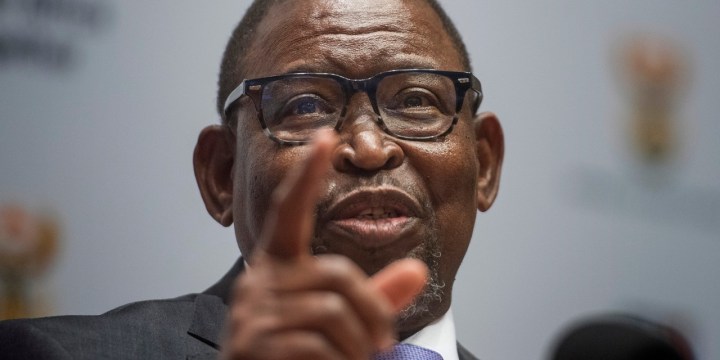SPONSORED CONTENT
South Africa’s mid-term budget crossroads

Addressing escalating debt, SOE bailouts, and tax reforms will be critical in the Medium-Term Budget Policy Statement, say Investec economists.
With anemic economic growth, the disparity between the government’s revenue and its spending continues to grow, raising concerns ahead of the mid-term budget.
Finance Minister Enoch Godongwana faces an uphill battle, with mounting municipal debt and escalating crises in energy and logistics. As we await his speech on the 1st of November, there is intense speculation on the course he might adopt. And make no mistake he has little room to maneuver.
Ahead of the speech, Investec Chief Economist Annabel Bishop and Treasury Economist Tertia Jacobs gave their views on what the Minister must prioritise and the tough climate within which he is operating. Both were appearing on Investec’s No Ordinary Wednesday podcast.
Bishop says the financial tightrope that South Africa is currently walking has three potential solutions: increasing revenue through taxes, cutting back on expenditure, or escalating borrowing.
Considering the country’s political landscape with an upcoming election in 2024, substantial expenditure cuts are not anticipated. Rather, she says the government will be more inclined towards consolidating administrative costs, with a potential focus on the amalgamation of various departments.
For some time, tax increases, specifically capital gains, have been under discussion. One possible approach says Jacobs could be a non-adjustment for higher inflation, which could generate an additional R20 to 30 billion in revenue. However, this could have ramifications pushing many into higher tax brackets.
READ MORE: SA’s fiscal problem – what we can do about it
Budget deficit a cause for concern
The looming budget deficit is another pressing concern, say the pair. Current projections suggest it may escalate to about 5% of the GDP, with national debt potentially skyrocketing to over 72% of the GDP, and some experts even suggesting it could approach 80%.
Jacobs believes that the budget deficit’s rise can be attributed to weaker growth and plummeting commodity prices which are severely affecting corporate income taxes.
The silver lining, however, could be a rejuvenated economy, provided the energy sector stabilises and sees an influx of capacity. A boost in consumer spending could also be on the horizon if interest rates moderate in the upcoming year.
However, state-owned enterprises (SOEs) like Eskom and Transnet continue to drain the government’s resources. The ideal scenario, says Bishop, is for these SOEs to be self-reliant, negating the need for consistent bailouts.

“What I would like to see from the finance minister is a strengthening of this bailout plan for Eskom where we actually do now push the concessioning of the power stations, and don’t allow the access of financing for the debt repayment if they don’t do that.” – Annabel Bishop, Investec Chief Economist
Commodity market decline, social grants and El Nino
A concerning element of South Africa’s economic landscape remains the oscillation of commodity prices. Jacobs says the boom in 21-22 when escalating commodity prices, coupled with the COVID crisis and Europe’s energy predicament, worked in the nation’s favour.
But recent declines exacerbated by the logistics crisis, have put pressure on mining companies.
A critical expenditure aspect that the government needs to tackle head-on is social grants. With around 9 million people relying on these grants, the cost is astronomical, especially with the potential increase of the Social Relief of Distress Grant, which might necessitate further tax hikes.
The unpredictable nature of climate change, with patterns like the El Nino, also casts a shadow over South Africa’s agricultural sector. Bishop fears that adverse weather conditions could trigger inflation, putting additional strain on the economy.
Yield curve steepens
Jacobs also referenced the current bond yield curve – a graph that shows the interest rates of government bonds with different maturities. The yield curve can provide insight into the future direction of the Reserve Bank’s interest rates and reflects market perceptions about inflation.
For South Africa, a notably steep yield curve suggests concerns about the nation’s finances and the potential increase in government bond supply due to revenue shortfalls and spending risks.
She says the current steepness of the yield curve mirrors scepticism among investors regarding the government’s ability to enact necessary reforms. Sustainable economic growth, she says, is essential to flatten the curve, which in turn will boost revenue.

“On the private sector side, we need to see the commitment and urgency around the implementation of energy and the logistics reform. That will be very positive for the economic outlook and that will really be a big boost to confidence.” – Tertia Jacobs, Investec Treasury Economist
SA under the rating agencies’ microscope
The country’s risk premium has increased, mainly due to worsening fiscal conditions. Furthermore, since South Africa lost its investment grade rating in March 2020, national investors have become wary, says Jacobs.
The recent selloff in US treasury markets, coupled with global market trends, has seen many investors favouring the more stable US treasury yield over riskier options in South Africa.
LISTEN: Unpacking the bond market crash
The upcoming mini budget is thus crucial, as it will provide a clearer picture of the government’s commitment to fiscal consolidation and the potential for economic growth.
Both economists agree that as we approach the mid-term budget speech, South Africa stands at a crossroads. While the path forward is uncertain, what remains clear is that the country’s economic strategy needs an overhaul.
With persistent challenges and looming threats like potential credit rating downgrades, the government’s decisions in the coming months will be crucial for the nation’s financial future.
Stay informed. Sign up for regular insights from Investec. DM/BM
By Jeremy Maggs for Investec

















